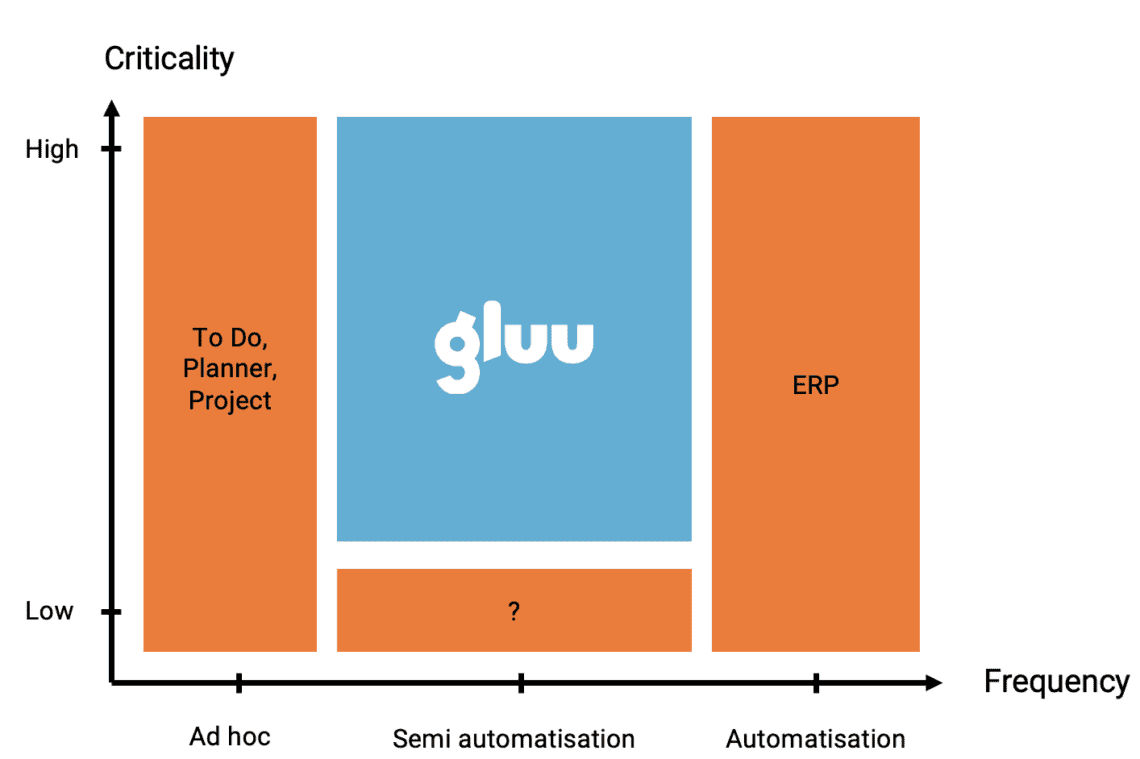
The sweet spot of Gluu

There will always be a discussion about the value of introducing new software in a company. Perceived value, expected value, future value and timelines for the real value. We sometimes give talks on this topic and this article is a distillate of a Q&A and discussions that followed after one of those talks.
The premise is simple: “If I have 100 repetitions of a process every day – isn’t it annoying to use Gluu and click “Completed” on every task in the same process?” The answer is, of course: “Yeah – that sounds like a waste of time – don’t do that”.
But! If it is a critical process and you actually need proof of every single time it happens a day to satisfy an auditor or the Legal team – then the answer becomes a clear: “Maybe!”
When introducing criticality to the equation, a simple answer becomes a bit harder to offer, because then there is a field of opportunities within: “High or Low repeatability” and “High or low criticality”. And there are even a lot of grey areas in that field. This article will discuss that playing field.
On the lower end of the question, we have: “What about tasks that occur rarely? “ Well, those are – “ad hocs” and they don’t make much sense to register inside of Gluu, as they will never be repeated. At least if you can easily prove that they’re completed correctly and to the best of the company standards. But that requires bright employees rather than good processes. If you can save the evidence in an email or on the Sharepoint it’s fine. If not, you can consider using Gluu for the sake of storing evidence.
Furthermore, tasks with low criticality that are done more than once, is something you should consider whether to document. There might be a service for that out there, but from a business perspective you should consider if you can avoid them.
Back to the initial question: Those processes that are repeated 100 times or even more a day could be documented in Gluu, but you should strongly consider to fully automate that business process. ERP systems are probably your best choice for this.
And even for that conclusion there is a but: It could still make sense to map and create the high-frequency process (knowing that people won’t follow it to the letter every time) if you have it for training and education purposes. New employees could benefit from understanding how to do it and then start from there.
So, there is both an upper and a lower limit.
Where is the sweet spot for using Gluu?
The Gluu sweet spot is in the “reasonably critical” and “more often than once” – “but not super often”- area. That calls for a visualisation:

Gluu brings you the most value in the semi-automation area. And all digital transformation journeys will at some point be in this area. Some are moving towards automation, some are not – and that’s fine. Close to full automation there’s even RPA as a great option, so you don’t have to leave out one option, just because you’re using another.
Businesses are evolving and so should their IT landscapes. If you take the knowledge from your customer’s semi-automated processes as input for an ERP tender project, you will have a much stronger definition of what is needed. Looking for more information about RPA? You can read how to set up RPA in our article.
The benefits of semi-automation
In this day and age, not automating your processes (to some extent) is not really an option anymore. However, organisations often think that only with full automation they will get full value: lower the labour costs and increase production.
This is a very common misconception.
We have seen many organisations that sprint towards full business process automation with a huge IT software solution to support it. Many forget that once you have implemented an IT solution, you are now at the mercy of the features provided by the software. What if your problem can’t be solved there? Or that outside changes affect the requirements for your delivery – and that the software that used to be a perfect fit now can’t deliver?
Implementation of new IT systems (usually ERP) is usually an enormous leap in the digitalisation journey. But they change the question from: “What business problem do you want to solve?” to “can you fit your problem into what the IT system can deliver?”.
Keeping things semi-automatedbrings a lot of value as it:
- keeps your business processes agile
- gives space for continuous improvement
If this is where your organization is heading towards or is already, Gluu is a great solution for you.
👉 Recommendation: This provides valuable insight into how Gluu can be a beneficial platform for any organization looking to improve its business strategy and efficiency. With its comprehensive toolset, it can serve as a single, convenient space for all your organizational needs. Its unique sweet spot diagram further simplifies the understanding of how it streamlines different processes. A must-read for business owners and managers who aim to enhance their business’s strategic alignment and workflow efficiency. Guaranteed, you won’t look at organizational efficiency the same way again after reading this piece.
Final thoughts
There are definitely limits to semi-automation. Do not click on “I have completed the task” a 1000 times a day. That is the upper limit. Between “semi-automation” and “ full automation” there are potential benefits in using RPA to carry some of the workload.
And do not spend your time defining a process or task for a problem that only needs solving once. That is the lower limit. Assessing criticality requires critical thinking. If you need our experience please do not hesitate to reach out and book a demo with Gluu.
Frequently Asked Questions
Gluu sets itself apart from other software solutions by adapting to different industries and company sizes. Its design incorporates scalability to cater to diverse business needs, from start-ups to large enterprises.
Gluu optimizes various business processes like task management, communication, compliance, and quality improvement. It acts as a comprehensive platform for managing all business processes and aids in increasing operational efficiency.
Yes, Gluu can integrate with other business systems using its robust API. This allows for real-time data exchange, enhancing Gluu’s functionality and ensuring seamless business operations. Help is provided throughout the process, making Gluu a versatile tool for businesses.



